
Downing Street is a street in Westminster in London that houses the official residences and offices of the Prime Minister of the United Kingdom and the Chancellor of the Exchequer. Situated off Whitehall, it is 200 metres (660 ft) long, and a few minutes' walk from the Houses of Parliament. Downing Street was built in the 1680s by Sir George Downing.

The Chancellor of the Exchequer, often abbreviated to Chancellor, is a senior minister of the Crown within the Government of the United Kingdom, and head of His Majesty's Treasury. As one of the four Great Offices of State, the chancellor is a high-ranking member of the British Cabinet.
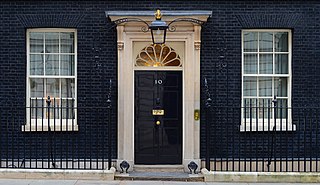
10 Downing Street in London is the official residence and office of the Prime Minister of the United Kingdom.
A whip is an official of a political party whose task is to ensure party discipline in a legislature. This means ensuring that members of the party vote according to the party platform, rather than according to their own individual ideology or the will of their donors or constituents. Whips are the party's "enforcers". They work to ensure that their fellow political party legislators attend voting sessions and vote according to their party's official policy. Members who vote against party policy may "lose the whip", being effectively expelled from the party.
In the United Kingdom, there are several Secretaries to the Treasury, who are Treasury ministers nominally acting as secretaries to HM Treasury. The origins of the office are unclear, although it probably originated during Lord Burghley's tenure as Lord Treasurer in the 16th century. The number of secretaries was expanded to two by 1714 at the latest. The Treasury ministers together discharge all the former functions of the Lord Treasurer, which are nowadays nominally vested in the Lords Commissioners of the Treasury. Of the Commissioners, only the Second Lord of the Treasury, who is also the Chancellor of the Exchequer, is a Treasury minister.
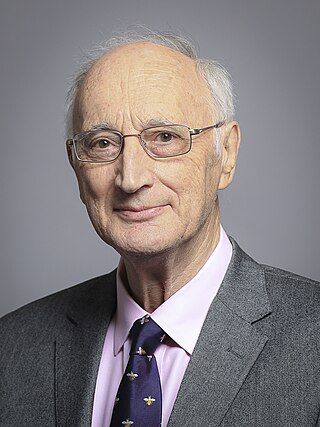
George Samuel Knatchbull Young, Baron Young of Cookham,, known as Sir George Young, 6th Baronet from 1960 to 2015, is a British Conservative Party politician who served as a Member of Parliament (MP) from 1974 to 2015, having represented Ealing Acton from 1974 to 1997 and North West Hampshire from 1997. He has served in Cabinet on three occasions: as Secretary of State for Transport from 1995 to 1997; as the Leader of the House of Commons and Lord Privy Seal from 2010 to 2012; and as Chief Whip of the House of Commons from 2012 to 2014.
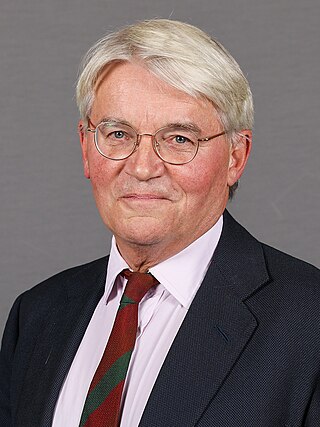
Andrew John Bower Mitchell is a British politician currently serving as Deputy Foreign Secretary since 2024 and Minister of State for Development and Africa since 2022. A member of the Conservative Party, he has been the Member of Parliament (MP) for Sutton Coldfield since 2001 having previously served as the MP for Gedling from 1987 to 1997. Mitchell served in the Cabinet as Secretary of State for International Development from 2010 to 2012 and then briefly as Government Chief Whip in the House of Commons in late 2012.
The Chief Whip is a political leader whose task is to enforce the whipping system, which aims to ensure that legislators who are members of a political party attend and vote on legislation as the party leadership prescribes.
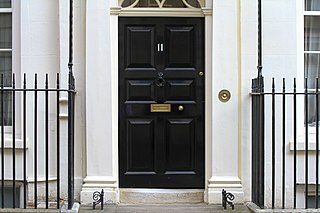
11 Downing Street in London, also known colloquially in the United Kingdom as Number 11, is the official residence of the Chancellor of the Exchequer. The residence, in Downing Street in London, was built alongside the official residence of the Prime Minister at Number 10 in 1682.
In the United Kingdom there are at least six Lords Commissioners of His Majesty's Treasury, serving as a commission for the ancient office of Treasurer of the Exchequer. The board consists of the First Lord of the Treasury, the Second Lord of the Treasury, and four or more junior lords acting as whips in the House of Commons to whom this title is usually applied.

Carlton House Terrace is a street in the St James's district of the City of Westminster in London. Its principal architectural feature is a pair of terraces, the Western and Eastern terraces, of white stucco-faced houses on the south side of the street, which overlook The Mall and St. James's Park. These terraces were built on Crown land between 1827 and 1832 to overall designs by John Nash, but with detailed input by other architects including Decimus Burton. Construction was overseen by James Pennethorne. Both terrace blocks are Grade I listed buildings. A separate but linked cul de sac at the terrrace's western end is named Carlton Gardens.
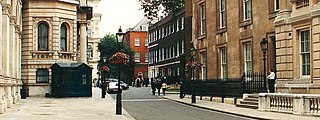
9 Downing Street is one of the buildings situated on Downing Street in the City of Westminster in London, England. It has been used as a separate address to the better known 10 Downing Street since 2001 for various government functions.

Red boxes, or sometimes ministerial boxes, are a type of despatch box produced by Barrow Hepburn & Gale or Wickwar & Co and are used by ministers in the British government and the British monarch to carry government documents. Similar in appearance to a briefcase, they are primarily used to hold and transport official ministerial papers. Red boxes are one modern form of despatch boxes, which have been in government use for centuries. Despatch boxes of a very different design remain in use in the chamber of the lower house of the British and Australian parliaments. Those boxes hold religious books for swearing-in new members of the chamber, but are also used as lecterns by front bench members.

Victoria Barracks Melbourne is an Australian Government building located on St Kilda Road in Melbourne, Australia. It was constructed in the mid-to-late 19th century as barracks for British colonial forces in Australia and was the headquarters of the Department of Defence from 1901 to 1953, also housing Australia's war cabinet during World War II. It is still used as a Department of Defence administrative centre in the present day.

Chief Mouser to the Cabinet Office is the title of the official resident cat at 10 Downing Street, the residence and executive office of the Prime Minister of the United Kingdom in London. There has been a resident cat in the British government employed as a mouser and pet since the 16th century, although modern records date only to the 1920s. Despite other cats having served Downing Street, the first one to be given the official title of chief mouser by the British government was Larry in 2011. Other cats have been given this title affectionately, usually by the British press. In 2004 a study found that voters' perceptions of the chief mouser were not completely above partisanship.

John Gardiner, Baron Gardiner of Kimble is a British politician. He is a life peer, and has served as Senior Deputy Speaker of the House of Lords since May 2021.
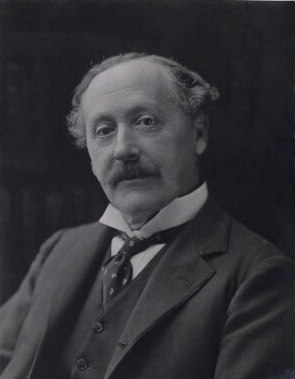
Herbert John Gladstone, 1st Viscount Gladstone, was a British Liberal politician. The youngest son of William Ewart Gladstone, he was Home Secretary from 1905 to 1910 and Governor-General of the Union of South Africa from 1910 to 1914.

The Embassy of the United Kingdom in Bangkok is the chief diplomatic mission of the United Kingdom in Thailand. Established as an embassy in 1947, its history dates to 1856 when a British consul was first posted in Bangkok following the signing of the Bowring Treaty. First established on Charoen Krung Road by the Chao Phraya River, the mission relocated to a new site on the corner of Phloen Chit and Witthayu Roads in 1922. Originally a rural location on the outskirts of the city, the area soon developed into one of the city centre's prime locations. The compound remained a leafy oasis amidst its densely developed surroundings throughout the 20th century, but was sold to Central Group at record-setting prices, first partially in 2007, then completely in 2017. The embassy is now based in an office building on Sathon Road, while its original buildings, including the ambassador's residence, have been demolished to make way for redevelopment.
On 3 September 2019, the British Conservative Party withdrew the whip from 21 of its MPs who had supported an emergency motion to allow the House of Commons to undertake proceedings on the European Union (Withdrawal) Bill on 4 September. In the hours after the vote, the Chief Whip Mark Spencer informed the rebel MPs that they were no longer entitled to sit as Conservatives. This led to the loss of the Conservative/DUP majority in the Commons.















